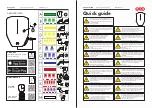
SENS MicroGenius S2/S4 Technical Manual
63
13
GLOSSARY
Original Factory Configuration
Configuration set at the factory. Charger operates using
settings configured at the factory per customer order. See
configuration details on inside cover label.
Float Voltage
Float output voltage is used to maintain batteries in a fully
charged state and prevents a fully charged battery from
becoming overcharged.
Boost Voltage
A higher output voltage used to quickly recharge batteries
and ensure that all battery cells in a battery string are
charged to the same level. “Boost” and “Equalize” (see
below) are often used synonymously, however, “Boost” is
employed most frequently in the context of accelerating the
recharge of a fully or partially discharged battery that is
periodically discharged. The MicroGenius S2/S4 chargers use
the term “Boost” for the higher output voltage mode (see
section
9.3
)
Equalize Voltage
A higher output voltage used to quickly recharge batteries
and ensure that all battery cells in a battery string are
charged to the same level. “Boost” (see above) and
“Equalize” are often used synonymously, however,
“Equalize”
is employed most frequently in the context of optimizing the
maintenance of an already charged battery that is primarily
charged using Float voltage.
Battery Type
Indicates the type of battery being charged. Battery type is
selected when ordering charger and may be adjusted using
the front panel keypad. Supported battery types include
flooded lead-acid, absorbed glass mat (AGM), valve-regulated
lead-acid, nickel-cadmium and ultracapacitors.
Configuration Code
Indicates charger output voltage configuration. Configuration
code is included on the inside cover label.
SAE J1939 (CANbus)
J1939 is a communications protocol provided by SAE
International and used in the commercial vehicle area for
communication between the charger and genset controller.
Modbus
Modbus is an application layer messaging protocol provided
by Modbus Organization and used for client/server
communication. Modbus is provided over RS-485 in ASCII or
RTU mode or over TCP/IP as an option.








































